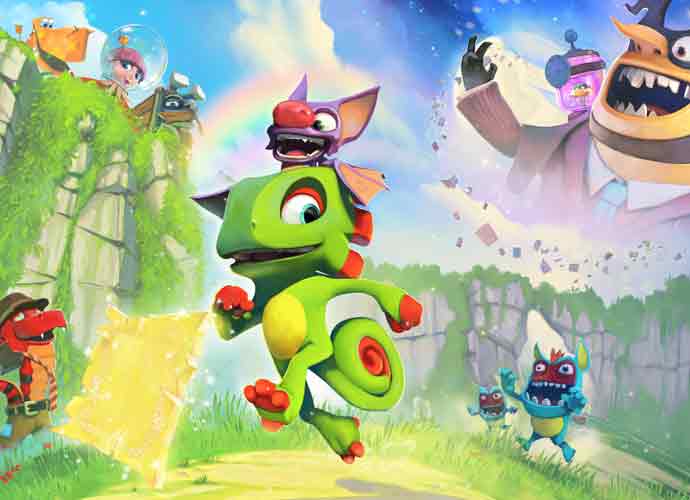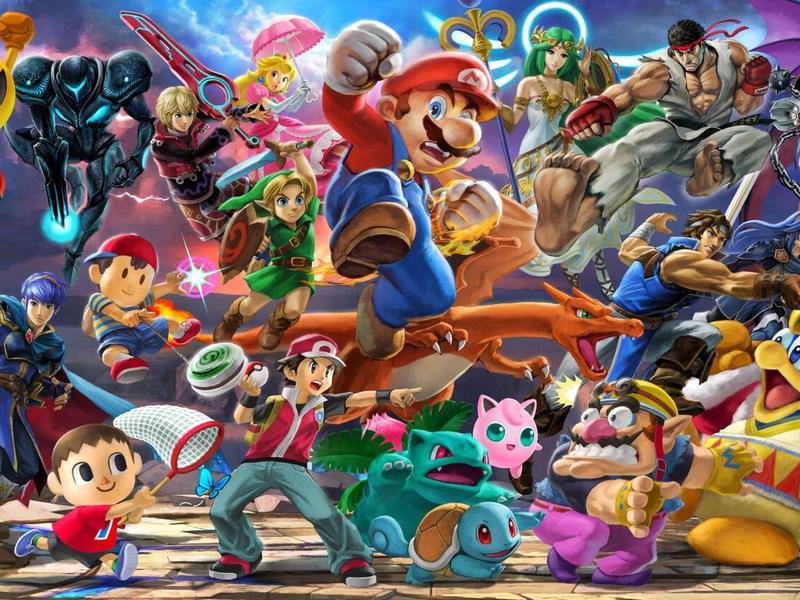‘Yooka-Laylee’ Game Review: What’s Up With That?

Yooka-Laylee (Playtonic Games)
Note: This review of Yooka-Laylee was written prior to the release of the commendable “Spit ‘N’ Polish” patch. Additionally, the game was played on an Xbox One.
The fifth generation of video games served as a transitional period for the industry, with patrons eager to see how cherished properties would adapt to the third dimension. Nintendo’s Super Mario 64, while an imperfect interpretation of his prior 2D outings, successfully brought the platforming icon jumping into a 3D adventure, codifying a new templet for the genre.
Rare was inspired by the plumber’s blueprint when creating their new flagship Nintendo 64 game: Banjo-Kazooie. While the Banjo character was formally introduced earlier via Diddy Kong Racing, his first starring role, released in 1998, was a critical and financial success, becoming the essential entry in the “collectathon” sub-genre of platformers. Two years later, it received a direct sequel in Banjo-Tooie. Rare’s Donkey Kong 64 closely adhered to Banjo’s templet as well, although it channeled its worst aspects.
Banjo went into hibernation following Microsoft’s acquisition of Rare in 2002, initially only remerging for two low-key Game Boy Advance titles. It took until 2008’s Banjo-Kazooie: Nuts & Bolts for the series to return in a pronounced way, although its stress on vehicle construction proved polarizing. Currently, Banjo continues to make cameos, and his three mainline games are bundled within the Xbox One’s Rare Replay anthology. Of Rare’s stable of mascots, I’d wager Banjo remains the most popular.
As such, it was unsurprising how, seven years later, excitement arouse when a spiritual successor was teased. Playtonic Games, a new studio composed of several Rare vets, later formally unveiled their project: Yooka-Laylee, a throwback to Banjo-Kazooie and Tooie. It broke Kickstarter records, ensuring it would not only be funded, but that it would also exceed its preliminary goal.
Yooka-Laylee launched on April 11 for the PlayStation 4, Xbox One and PC, with a Nintendo Switch version coming later. So, does this 64-era throwback successfully channel the high points of yesteryear or are some formulas best left in the past?
YOOKA-LAYLEE GAME REVIEW
Upon starting, an opening cinematic begins that sums up our heroes’ motivation: Capital B stole their book, the book’s magical pages – known as Pagies – flew out of it, and Yooka and Laylee need to retrieve the Pagies and the book that held them. It’s not a deep tale, but it serves its intended purpose while establishing one of Yooka-Laylee’s brighter assets: its personality.
Rare’s classics offered a distinctive vibe unlike other titles on the market, from their charming casts to the whimsical, self-aware stories and lore adjoining them. Yooka-Laylee doesn’t quite recapture the persona of Rare’s heyday, but there’s a convincing resemblance, largely in part to how our new duo is respectively based on Banjo and Kazooie. Yooka’s the cool, level-headed half while Laylee is rude and hostile. However, while their personalities aren’t completely 1:1 with the bear-and-bird pair, the dynamic they share basically is. In conversations with their supporting cast, Laylee’s rude quips and fourth wall-breaking allusions permeate her dialog whereas Yooka remains polite and (infrequently) scolds his partner.
This relationship was handled better in the Banjo games, though. Therein, select members of the cast bounced off Kazooie’s sarcasm, making for more interesting, authentic exchanges. Contrariwise, few of the characters in Yooka-Laylee offer retorts to the bat, resulting in writing that’s more redundant. The only recurring character who attempts to counter her antagonism is Trowzer, one of the game’s more vital figureheads.
Yooka and Laylee, as you’d expect, function as one character. Specifically, you primarily maneuver as Yooka while Laylee adorns his head. They’re responsive, even if they lack a sense of weight. Some of the moves the lizard-and-bat duo learn from Trowzer are stand-ins for some of their precursors’ moves, too.
The two are powered by health and stamina meters, with the latter regenerating automatically after a brief period. Their stamina fuels their advanced techniques, many of which thematically revolve around their anatomy and species. Yooka, for example, can utilize his tongue for various deeds and Laylee’s wings can extend their airtime. Optional items can be found in each world, including the hub, to enhance the team’s health and stamina. Butterflies that frolic across the landscape regenerate health or stamina depending how you inject them.
As per the genre’s standard, enemies litter Yooka-Laylee’s terrain. The combat mechanics aren’t the gameplay’s focal point, but they do depict its overall roughness; Yooka’s signature attacks fail to provide you with adequate feedback. Banjo’s equivalent strikes gave a greater degree of responsiveness through enemies’ recoil animations and sound effects. Conversely, depending on the adversary, it might take you a few moments to comprehend if your assaults are accomplishing anything here. And, as a whole, most of the character animations are stiff.
Yooka-Laylee’s opening area appropriately serves as its tutorial. During this phase, you learn the rudiments: jumping, attacking and crouching. Once you enter Hivory Towers, the hub, the game truly begins. As you collect more Pagies, you can spend them to unlock new worlds – referred to in-universe as Grand Tomes – or expand those you’ve already unlocked. Ultimately, you’ll need to acquire 100 of the floating, gold pieces of paper to earn the right to challenge Capital B. There are 145 Pagies to acquire in total, meaning you can skip missions that are too arduous or unsatisfying.
Hivory Tower is enormous and questionably mapped-out, foreshadowing Yooka-Laylee’s biggest fundamental misstep: its levels are overdesigned. The number of objectives in each Grand Tome – once expanded, all five worlds hold 25 Pagies – is fine, but they’re spread throughout wide, often unfocused sprawling areas. Mario 64 and the first Banjo had more compact zones, but space was used far more astutely therein. And, unfortunately, Yooka-Laylee‘s final world is especially disjointed to transverse, even if it’s for thematic reasons. Thankfully, however, all five Grand Tomes are aesthetically pleasing, which makes trekking from one corner to another more bearable. Plus, discoverable shortcuts exist which also help.
As for the objectives themselves, there’s a solid amount of variety, with the highlights demonstrating the aptitude of the development team. These livelier spots encompass the more focused platforming set pieces in Tribalstack Tropics and Moodymaze Marsh, as well as the Knight Lore-inspired Icymetric Palace.
Unfortunately, many of the assignments are comprised of unimaginative concepts, from guiding seeds into holes to finding missing pigs or Pagies scraps. These aren’t clever scenarios, they’re simple, bland chores, some of which wouldn’t have entertained even during Banjo’s time. Differing objectives can provide an appreciated change of pace, and even Super Mario Galaxy and Galaxy 2, two games I’ve professed immense affection for, would postulate some variances in their goals. The issue with Yooka-Laylee, however, is that a considerable number of its missions aren’t engaging or fun.
There are recurring exercises across the Grand Tomes that have Pagies tethered to them. Rextro Sixtyfourus, the antiquated polygonal dinosaur, built an arcade kiosk in each realm, all exhibiting a minigame modeled after recognizable video games. Likewise, the discarded minecart Kartos resides in a desolate juncture in each zone. Chat with him and he’ll let you ride him across an obstacle course to collect gems. Finally, Dr. Puzz supplies our buddy duo with a unique transformation tailored for each Grand Tome. The controls associated with their segments are, at best, adequate. At their worst, they’re crippled.
In Kartos’ case, he automatically propels forward. His supplementary options are sparse – you can speed up, slow down and shoot a cannonball – yet they fail to communicate basic information; his skills all have a cooldown period to prevent the player from abusing them, but there’s no visual or audio indication of when they become usable again.
Naturally, all five Grand Tomes house their own boss. They, too, aren’t exceptionally fetching. The third boss is the outlier, however; he telegraphs his attacks well and it’s an overall satisfying confrontation. Without going too much into spoiler territory, while the final boss has entertaining portions dispersed throughout the encounter, he nevertheless overstays his welcome, cumulating in a final phase that continues some of the finer control problems that are prevalent.
The console versions of the game run at an inconsistent 30 FPS. (If the PC version is an option for you, it apparently runs at 60 FPS.) Likely as a byproduct of the Unity engine powering it, Yooka-Laylee is plagued with sporadic slowdowns. They shouldn’t ruin the experience and they’ll rarely impede your ability to perform, but they still inhibit the immersion.
Yooka and Laylee are also let down by their game’s camera, which often wrestles with you when you’re given a task that demands precision. Regardless of what you try to do with it, the camera incessantly snaps back to another orientation. This is also compounded with the awkward flying controls, which makes the task of guiding the duo when airborne an exercise in patience.
Your progress is blocked at three junctures by Dr. Quack’s quizzes. Therein, he questions you on trivia pertaining to various in-game details as a timer counts down. A casual level of observance should ensure passing on your first or maybe second try, although some of the possible questions require knowing the exact amount of Pagies or Quills you’ve amassed. The Banjo series has a tradition of quizzes, but they occur once per game near the climax and, at least during the original, it was a cute novelty. Now, it comes across as a waste of time.
Swinging back to the game’s positives, the art direction provides some appreciated comfort food. The colors are bright and cheerful, and the cast appropriately suits the cartoony dimension they inhabit. If you’re a fan of the work Kevin Bayliss and Steve Mayles did for Donkey Kong and especially Banjo, you’ll warm up to their new kids. I’d also like to honor a few of the entertaining details, such as how each world has its own stylized foot soldiers. My favorite element, however, is the goldfish who inconspicuously swims around Dr. Puzz’s head. I imagine this was a subtle callback to Banjo courtesy of Puzz’s character designer, Ed Bryan.
Yooka-Laylee soundtrack is also one of its greatest assets. It was composed by three veteran Rare musicians: David Wise, Grant Kirkope and Steve Burke. Kirkope primarily scored the themes for the Grand Tomes, which successfully channel his Banjo vibe while sounding more atmospheric. Wise’s contributions, instead, are primarily used to provide ambience for other moments, including some of the bosses and the Kartos sequences. Burke’s work consists of nine musical pieces, which are tied to Rextro’s games, and sound effects. Speaking of, the sound effects are what you’d expect from a Banjo successor, mumbles and all.
Yooka-Laylee calls back to a phase when gaming was trying to acclimate to the third dimension, spawning a sub-genre where scavenger hunts and obstinate minigames were at the forefront of the experience, sometimes at the expense of genuine platforming. Banjo-Kazooie and Tooie, both of which are now nearly two decades old, were exciting back then, and I don’t believe their golden shine has completely faded. Banjo-Kazooie isn’t exactly a platforming pinnacle, yet it still offers a great time on its own personalized terms.
Yooka-Laylee, however, is regrettably content to rest on the laurels of its developer’s legacy, afraid to experiment with the boundaries of its genre. The strong underlying facets that are present are stuck in a rough product. Overbearing map design and questionable Pagie objectives are core issues, to say nothing of the finer control problems, the camera and Playtonic’s programing oversights.
However, Yooka-Laylee was always honest about what it is: a truer attempt at a Banjo-Threeie than Nuts & Bolts proved to be. Thus, if Playtonic Games’ debut successfully tugged at your nostalgia strings, then you’ll derive some enjoyment with the lizard and bat. There is fun to be had here, and a sequel that irons out Yooka-Laylee‘s problems has enormous potential.






3 thoughts on “‘Yooka-Laylee’ Game Review: What’s Up With That?”